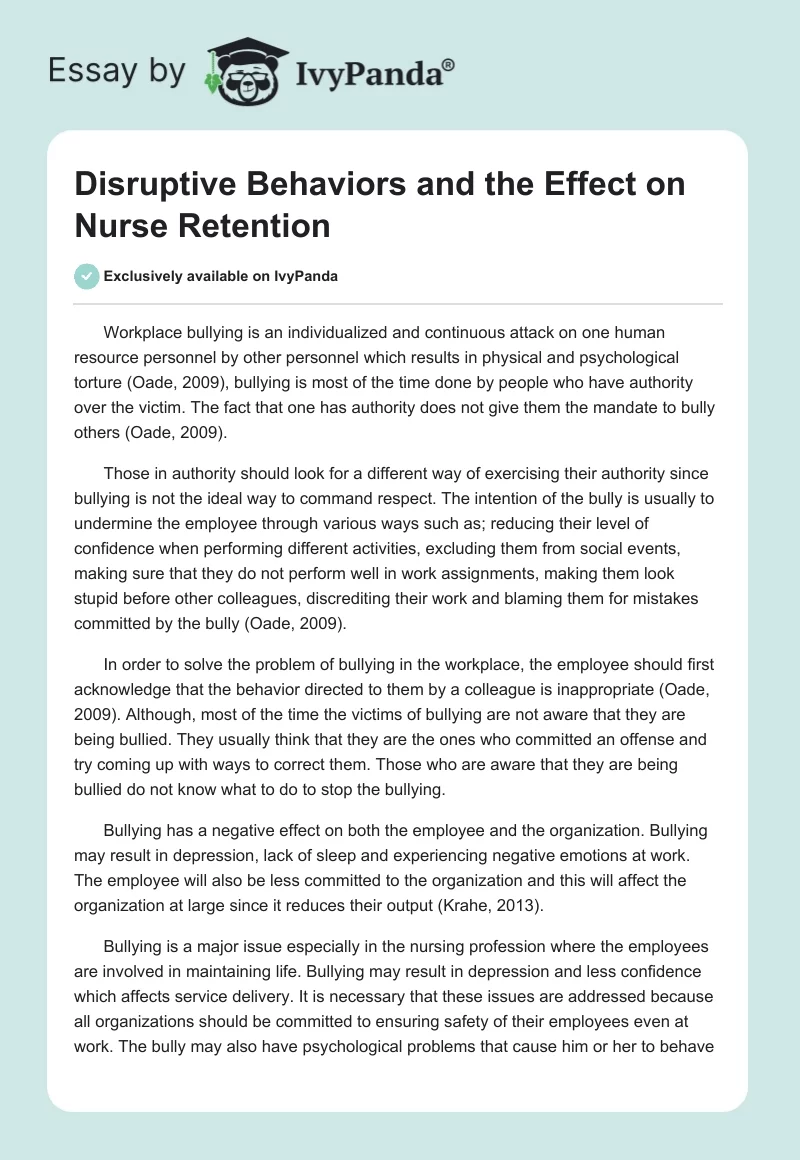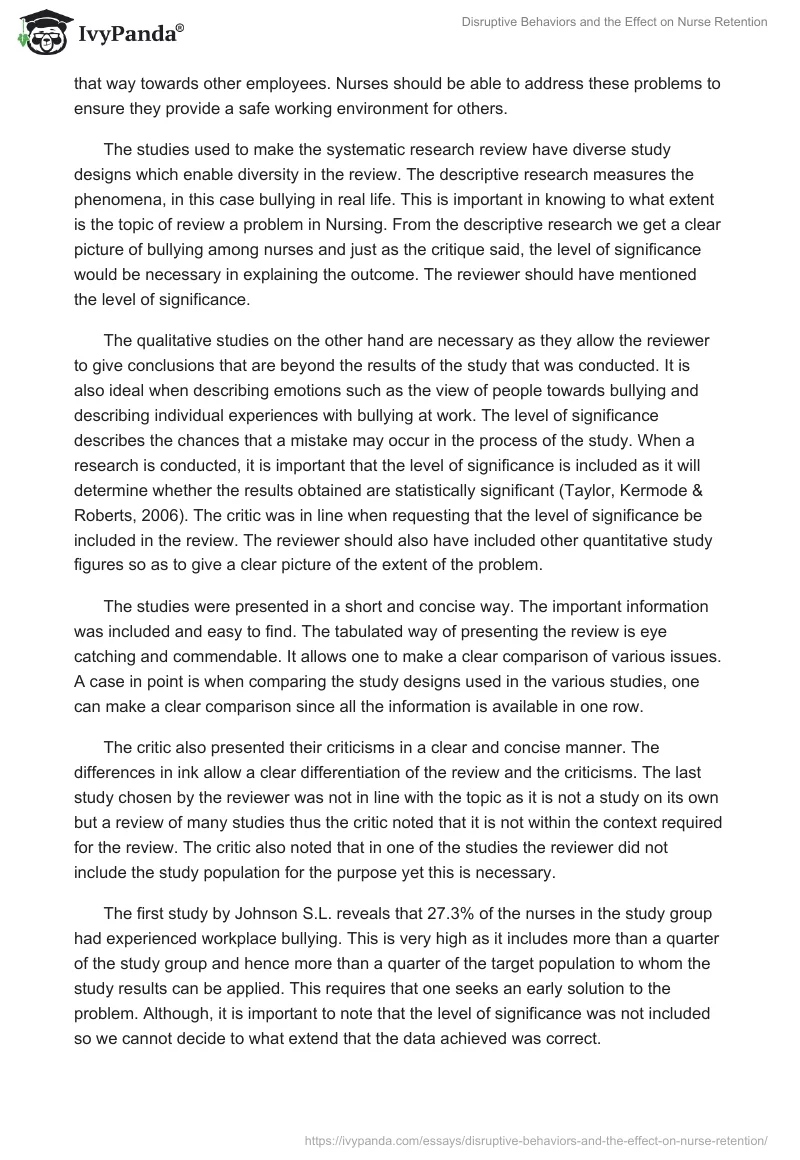Workplace bullying is an individualized and continuous attack on one human resource personnel by other personnel which results in physical and psychological torture (Oade, 2009), bullying is most of the time done by people who have authority over the victim. The fact that one has authority does not give them the mandate to bully others (Oade, 2009).
Those in authority should look for a different way of exercising their authority since bullying is not the ideal way to command respect. The intention of the bully is usually to undermine the employee through various ways such as; reducing their level of confidence when performing different activities, excluding them from social events, making sure that they do not perform well in work assignments, making them look stupid before other colleagues, discrediting their work and blaming them for mistakes committed by the bully (Oade, 2009).
In order to solve the problem of bullying in the workplace, the employee should first acknowledge that the behavior directed to them by a colleague is inappropriate (Oade, 2009). Although, most of the time the victims of bullying are not aware that they are being bullied. They usually think that they are the ones who committed an offense and try coming up with ways to correct them. Those who are aware that they are being bullied do not know what to do to stop the bullying.
Bullying has a negative effect on both the employee and the organization. Bullying may result in depression, lack of sleep and experiencing negative emotions at work. The employee will also be less committed to the organization and this will affect the organization at large since it reduces their output (Krahe, 2013).
Bullying is a major issue especially in the nursing profession where the employees are involved in maintaining life. Bullying may result in depression and less confidence which affects service delivery. It is necessary that these issues are addressed because all organizations should be committed to ensuring safety of their employees even at work. The bully may also have psychological problems that cause him or her to behave that way towards other employees. Nurses should be able to address these problems to ensure they provide a safe working environment for others.
The studies used to make the systematic research review have diverse study designs which enable diversity in the review. The descriptive research measures the phenomena, in this case bullying in real life. This is important in knowing to what extent is the topic of review a problem in Nursing. From the descriptive research we get a clear picture of bullying among nurses and just as the critique said, the level of significance would be necessary in explaining the outcome. The reviewer should have mentioned the level of significance.
The qualitative studies on the other hand are necessary as they allow the reviewer to give conclusions that are beyond the results of the study that was conducted. It is also ideal when describing emotions such as the view of people towards bullying and describing individual experiences with bullying at work. The level of significance describes the chances that a mistake may occur in the process of the study. When a research is conducted, it is important that the level of significance is included as it will determine whether the results obtained are statistically significant (Taylor, Kermode & Roberts, 2006). The critic was in line when requesting that the level of significance be included in the review. The reviewer should also have included other quantitative study figures so as to give a clear picture of the extent of the problem.
The studies were presented in a short and concise way. The important information was included and easy to find. The tabulated way of presenting the review is eye catching and commendable. It allows one to make a clear comparison of various issues. A case in point is when comparing the study designs used in the various studies, one can make a clear comparison since all the information is available in one row.
The critic also presented their criticisms in a clear and concise manner. The differences in ink allow a clear differentiation of the review and the criticisms. The last study chosen by the reviewer was not in line with the topic as it is not a study on its own but a review of many studies thus the critic noted that it is not within the context required for the review. The critic also noted that in one of the studies the reviewer did not include the study population for the purpose yet this is necessary.
The first study by Johnson S.L. reveals that 27.3% of the nurses in the study group had experienced workplace bullying. This is very high as it includes more than a quarter of the study group and hence more than a quarter of the target population to whom the study results can be applied. This requires that one seeks an early solution to the problem. Although, it is important to note that the level of significance was not included so we cannot decide to what extend that the data achieved was correct.
The second study by Gaffney, D., DeMarco, R., Hofmeyer, A., Vessey, J., & Budin, W., finds that when nurses were confronted with bullying, they accepted they were wrong and were willing to make amends. The conclusion is commendable as people are willing to respond to the problem. There should have been more clarity on who was confronted between the victims and the perpetrators.
The third study notes that there are five themes that have been linked to bullying at work. The themes are not mentioned so it is difficult to make conclusions about the study. It also finds an impact that is not described which should not have been included in the first place since the reviewer is not in a position to make conclusions about the study as the findings are not clear.
The last study finds that workplace aggression can be determined by different forms of emotional abuse among nurses at work. Most of the time workplace abuse is in form of psychological abuse and not physical. The review found that bullying is prevalent in workplaces and has an impact on both the satisfaction of the nurse and the work place. It is the role of every human resource department in an organization to ensure that their employees are satisfied. Dissatisfied employees will not be able to perform work that is quality and up to standard. Nurses have a role to provide care and bullying undermines this role.
Nursing students also choose an organization depending on bullying or not. They determine first if there is bullying in an organization and then decide on which action to take. Organizations that bully their employees are even more likely to bully trainees. In a place where there is bullying the workforce turnover will be high as people will use the organization as the last resort. They are even likely to get people with the least qualifications as those who have no other alternative are the ones who will opt to work there.
The conclusions also note that the studies do not give a remedy for the problem. It is important that a remedy be determined since just identifying a problem is not enough. The review notes that most organizations have a policy of addressing bullying at work. Future researchers may want to study these policies to find out how effective they are considering most perpetrators have senior positions in the organizations.
The review also concludes that the personnel should be educated on bullying. This is important as nurses may not even be aware that they are being bullied. The first step in solving bullying is to identify its existence (Oade, 2013). They should in addition be educated on how to deal with bullying in the case that it exists.
In summary, it is evident that bullying is a major problem within the nursing profession. It is commendable that the reviewer decided to choose this topic and to address it. This review increases awareness on the issue of bullying within the profession and it makes people interested. This interest will ensure that solutions are sorted. In addition to the creating awareness it may be necessary that the legislature is engaged in the issues relating to bullying at work. Government policies will be more effective than the institutional policies.
References
Krahe, B. (2013). The Social Psychology of Aggression. New York, NY: Psychology Press.
Oade, A. (2009). Managing Workplace Bullying: How to identify respond to and manage Bullying behaviors in a workplace. London, UK: Palgrave Macmillan.
Taylor, J. B., Kermode, S., & Roberts K. L. (2006). Research in Nursing and Health Care: Evidence for Practice. Sydney, Australia: Cengage Learning.


